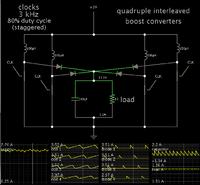ssheikmd
Member level 1
Dear All,
I have been reading interleaved boost converter related paper for couple of months now. I understand the concept of the converter. But, I couldn't find any useful formulas to design L&C values. Again, some claims the formulas are same as that of boost converter.. Here I need two things (a) Formulas to find L& C values. (b) If formulas are same as that of boost converter then in a two phase converter the inductor value should be as what we calculate or else should apply the parallel inductor equation..
Regards,
Sheik
I have been reading interleaved boost converter related paper for couple of months now. I understand the concept of the converter. But, I couldn't find any useful formulas to design L&C values. Again, some claims the formulas are same as that of boost converter.. Here I need two things (a) Formulas to find L& C values. (b) If formulas are same as that of boost converter then in a two phase converter the inductor value should be as what we calculate or else should apply the parallel inductor equation..
Regards,
Sheik
